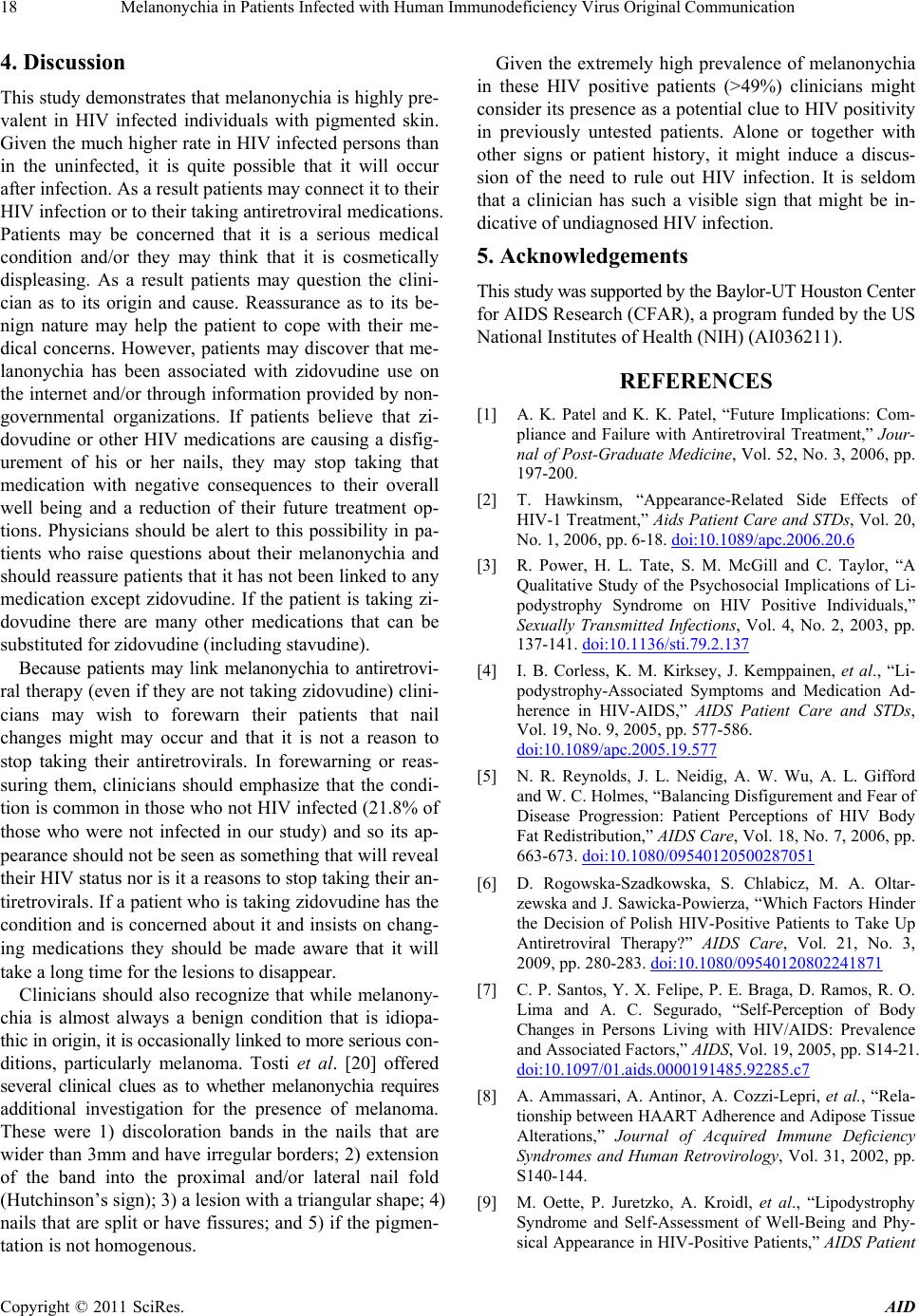
Melanonychia in Patients Infected with Human Immunodeficiency Virus Original Communication
18
4. Discussion
This study demonstrates that melanonychia is highly pre-
valent in HIV infected individuals with pigmented skin.
Given the much higher rate in HIV infected persons than
in the uninfected, it is quite possible that it will occur
after infection. As a result patients may connect it to their
HIV infection or to their taking antiretroviral medications.
Patients may be concerned that it is a serious medical
condition and/or they may think that it is cosmetically
displeasing. As a result patients may question the clini-
cian as to its origin and cause. Reassurance as to its be-
nign nature may help the patient to cope with their me-
dical concerns. However, patients may discover that me-
lanonychia has been associated with zidovudine use on
the internet and/or through information provided by non-
governmental organizations. If patients believe that zi-
dovudine or other HIV medications are causing a disfig-
urement of his or her nails, they may stop taking that
medication with negative consequences to their overall
well being and a reduction of their future treatment op-
tions. Physicians should be alert to this possibility in pa-
tients who raise questions about their melanonychia and
should reassure patients that it has not been linked to any
medication except zidovudine. If the patient is taking zi-
dovudine there are many other medications that can be
substituted for zidovudine (including stavudine).
Because patients may link melanonychia to antiretrovi-
ral therapy (even if they are not taking zidovudine) clini-
cians may wish to forewarn their patients that nail
changes might may occur and that it is not a reason to
stop taking their antiretrovirals. In forewarning or reas-
suring them, clinicians should emphasize that the condi-
tion is common in those who not HIV infected (21.8% of
those who were not infected in our study) and so its ap-
pearance should not be seen as something that will reveal
their HIV status nor is it a reasons to stop taking their an-
tiretrovirals. If a patient who is taking zidovudine has the
condition and is concerned about it and insists on chang-
ing medications they should be made aware that it will
take a long time for the lesions to disappear.
Clinicians should also recognize that while melanony-
chia is almost always a benign condition that is idiopa-
thic in origin, it is occasionally linked to more serious con-
ditions, particularly melanoma. Tosti et al. [20] offered
several clinical clues as to whether melanonychia requires
additional investigation for the presence of melanoma.
These were 1) discoloration bands in the nails that are
wider than 3mm and have irregular borders; 2) extension
of the band into the proximal and/or lateral nail fold
(Hutchinson’s sign); 3) a lesion with a triangular shape; 4)
nails that are split or have fissures; and 5) if the pigmen-
tation is not homogenous.
Given the extremely high prevalence of melanonychia
in these HIV positive patients (>49%) clinicians might
consider its presence as a potential clue to HIV positivity
in previously untested patients. Alone or together with
other signs or patient history, it might induce a discus-
sion of the need to rule out HIV infection. It is seldom
that a clinician has such a visible sign that might be in-
dicative of undiagnosed HIV infection.
5. Acknowledgements
This study was supported by the Baylor-UT Houston Center
for AIDS Research (CFAR), a program funded by the US
National Institutes of Health (NIH) (AI036211).
REFERENCES
[1] A. K. Patel and K. K. Patel, “Future Implications: Com-
pliance and Failure with Antiretroviral Treatment,” Jour-
nal of Post-Graduate Medicine, Vol. 52, No. 3, 2006, pp.
197-200.
[2] T. Hawkinsm, “Appearance-Related Side Effects of
HIV-1 Treatment,” Aids Patient Care and STDs, Vol. 20,
No. 1, 2006, pp. 6-18. doi:10.1089/apc.2006.20.6
[3] R. Power, H. L. Tate, S. M. McGill and C. Taylor, “A
Qualitative Study of the Psychosocial Implications of Li-
podystrophy Syndrome on HIV Positive Individuals,”
Sexually Transmitted Infections, Vol. 4, No. 2, 2003, pp.
137-141. doi:10.1136/sti.79.2.137
[4] I. B. Corless, K. M. Kirksey, J. Kemppainen, et al., “Li-
podystrophy-Associated Symptoms and Medication Ad-
herence in HIV-AIDS,” AIDS Patient Care and STDs,
Vol. 19, No. 9, 2005, pp. 577-586.
doi:10.1089/apc.2005.19.577
[5] N. R. Reynolds, J. L. Neidig, A. W. Wu, A. L. Gifford
and W. C. Holmes, “Balancing Disfigurement and Fear of
Disease Progression: Patient Perceptions of HIV Body
Fat Redistribution,” AIDS Care, Vol. 18, No. 7, 2006, pp.
663-673. doi:10.1080/09540120500287051
[6] D. Rogowska-Szadkowska, S. Chlabicz, M. A. Oltar-
zewska and J. Sawicka-Powierza, “Which Factors Hinder
the Decision of Polish HIV-Positive Patients to Take Up
Antiretroviral Therapy?” AIDS Care, Vol. 21, No. 3,
2009, pp. 280-283. doi:10.1080/09540120802241871
[7] C. P. Santos, Y. X. Felipe, P. E. Braga, D. Ramos, R. O.
Lima and A. C. Segurado, “Self-Perception of Body
Changes in Persons Living with HIV/AIDS: Prevalence
and Associated Factors,” AIDS, Vol. 19, 2005, pp. S14-21.
doi:10.1097/01.aids.0000191485.92285.c7
[8] A. Ammassari, A. Antinor, A. Cozzi-Lepri, et al., “Rela-
tionship between HAART Adherence and Adipose Tissue
Alterations,” Journal of Acquired Immune Deficiency
Syndromes and Human Retrovirology, Vol. 31, 2002, pp.
S140-144.
[9] M. Oette, P. Juretzko, A. Kroidl, et al., “Lipodystrophy
Syndrome and Self-Assessment of Well-Being and Phy-
sical Appearance in HIV-Positive Patients,” AIDS Patient
Copyright © 2011 SciRes. AID